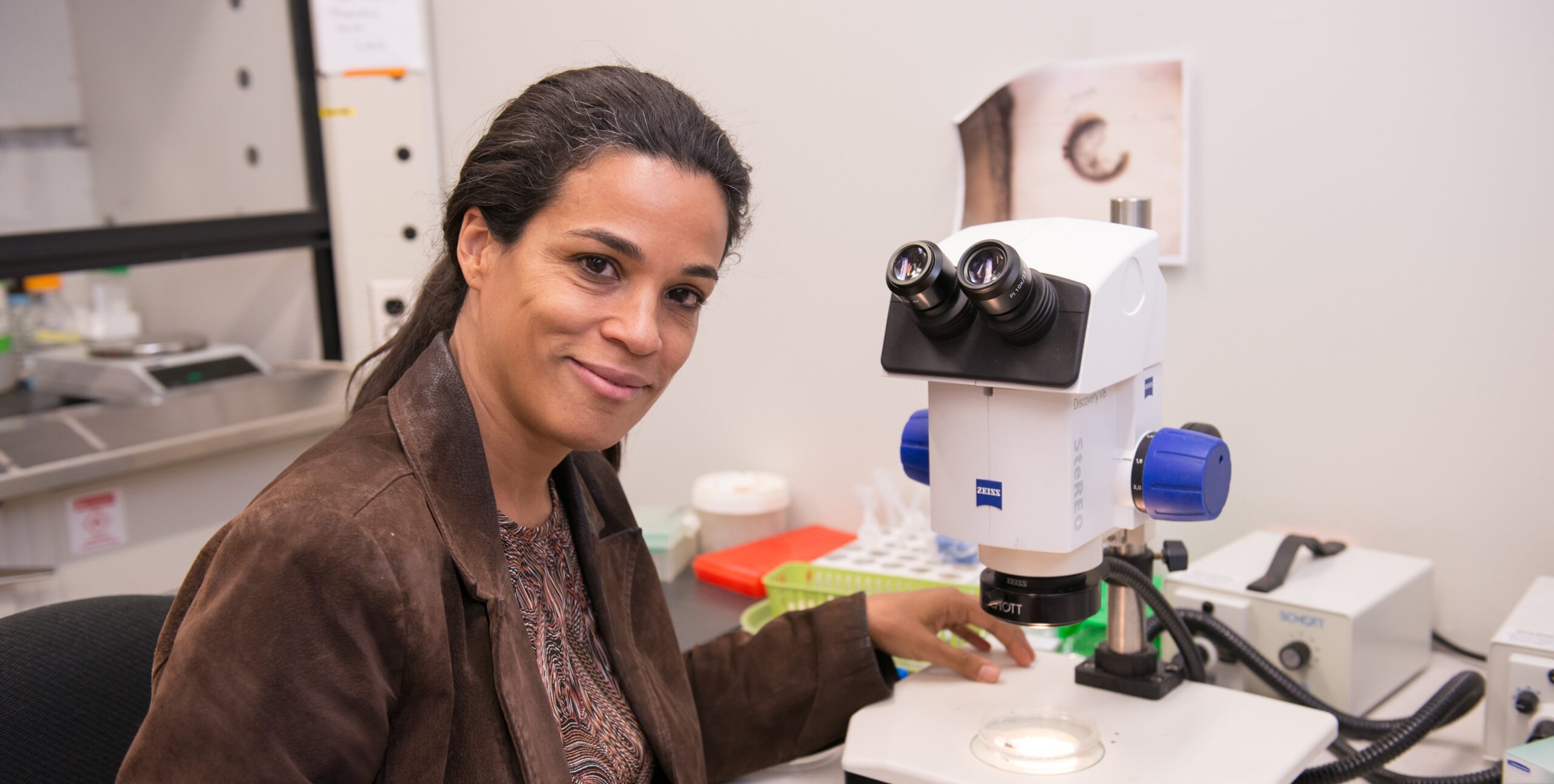Two years ago, developmental biologist Rachel Brewster embarked on a journey to learn more about how zebrafish embryos manage to survive for up to 50 hours without oxygen, with support from a Department of Defense Idea Discovery Grant. The ultimate goal was to develop new methods to preserve organs for transplant, allowing them to last longer and travel farther to those in need. NIH has now rewarded the noteworthy progress of Brewster’s research team with a $400,000, two-year Exploratory Research Award to continue the work.
When human cells are deprived of oxygen, their energy production drops dramatically—but demand for energy stays high. This leads to tissue damage and death, sometimes within only a few minutes. When zebrafish are faced with low-oxygen conditions, however, the amount of energy they demand also drops. “Even though the level of ATP [cellular energy] drops, it is met by an equivalent drop in ATP consumption,” Brewster explains. “It’s the equivalent of reaching a new status quo.”
Figuring out how zebrafish activate that shift has been central to the research team’s efforts. If the same pathway could be induced in human tissue, there is potential to significantly delay tissue deterioration.
Graduate students Jong Park and Tim Hufford and many undergraduates, including Austin Gabel ‘17, Bryanna Canales ‘19, Afia Osei-Ntansah ‘20, Darius McKoy ‘20, Nguyet Le ‘20, and Neil Tran ’20, have majorly contributed to the lab’s work so far. Brewster will continue to rely on their commitment to the project moving forward.
Clues from cancer
In collaboration with Young-Sam Lee at Johns Hopkins, Brewster found that when cells were deprived of oxygen, the amount of lactate in the cells quickly increased. Once thought to be nothing more than a byproduct of anaerobic energy production (often induced by intense exercise), some researchers have found that lactate “might be doing more than we thought,” Brewster says.
For example, in cancer cells, scientists have found that lactate stabilizes a protein called NDRG1. That induces blood vessels to grow toward the cells, delivering more oxygen and allowing them to multiply quickly even in low-oxygen environments.
Growing more cells takes a lot of energy. That’s the opposite of what Brewster is looking for, but still interesting. “We wondered if maybe cancer cells hijack this pathway,” Brewster says, “and if in normal cells the response…would be different but nevertheless adaptive.”
Brewster’s lab put the scientific process to work—conducting experiments, consulting existing research, and talking with fellow scientists—to help clarify the connection between lactate, NDRG1, and survival without oxygen.
Pieces of the puzzle
Brewster had an “epiphany moment” when she realized that the protein NDRG1 is found in the same cells that express a component of sodium-potassium pumps—structures that use large amounts of cellular energy. “Isn’t it intriguing,” she reflects, “that we were looking for a protein that may save energy, and we find it expressed in the exact same cells that have this super energy-demanding pump?”
Brewster explains that because these pumps are so energy-demanding, under long-term low-oxygen conditions many organisms degrade them to preserve energy. NDRG1 is generally found floating in the fluid inside cells, but when oxygen levels drop, it migrates to the cell membrane, where the pumps are embedded. Could it be part of the mechanism responsible for degrading the pumps?
Brewster’s lab took cells that didn’t produce NDRG1 and exposed them to an environment without oxygen to test that idea. “Much to our surprise and delight, we found that the pump was no longer degraded,” Brewster says. “So this is very exciting to us. It also opens up a whole series of other questions.”
Other scientists pointed out that if all NDRG1 did was degrade the pumps, the cell would eventually fill with water and burst open, so now the lab is wondering if NDRG1 does other things, too. For example, maybe it degrades other proteins embedded in the cell membrane that transport molecules in and out of the cell, such as water.
“In essence,” Brewster’s hypothesis goes, “NDRG1 renders the membrane impermeable. And of course, if the cell is to survive this, it would have to be able to reverse it.”
Next steps
Brewster’s collaborator at Harvard, Ryuji Morizane, has found that NDRG proteins are also found in human kidney organoids, and they appear to move to the cell membrane under low-oxygen conditions. So, “We’re left with the big question of why is this pathway protective in fish, and not in humans,” Brewster says. “And this is a very difficult question to answer.”
The lab’s goal is to learn enough about this pathway to harness it to improve organ transplant procedures and increase the number of lives saved by transplants.
Today, organs are preserved by making them very cold, which artificially slows down metabolism and the process of tissue degeneration for a few hours. However, that protocol may “bypass the NDRG response,” Brewster says. “If one could find a different way to prep the tissue, so that the response was triggered right before organ harvest, it could induce a protective state.”
“Maybe lactate is the molecule that triggers the response,” Brewster says. “Maybe it could be as simple as artificially modifying lactate levels before you harvest the organ, and that would do the job. But we don’t know if lactate does that yet.”
That’s what Brewster’s lab aims to find out next. With the new grant, they’ll explore what triggers NDRG to move to the cell membrane—lactate or another factor—and what mechanism degrades the pumps. “We want to know if lactate is that magic molecule that does it all,” Brewster says. “And if it isn’t lactate, we want to be searching for that other molecule.”
Even if they don’t find all the answers, each step in the research brings Brewster’s team closer to solving a cellular mystery and saving lives.
Image: Rachel Brewster in her lab. Photo by Marlayna Demond ’11 for UMBC.
Tags: Biology, CNMS, GradResearch, Research, Undergraduate Research

